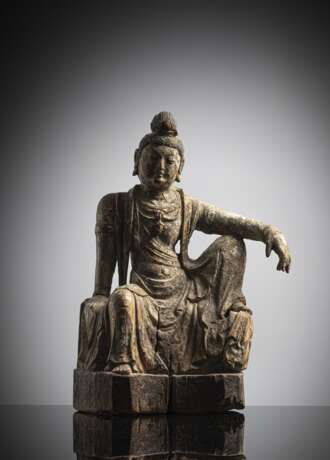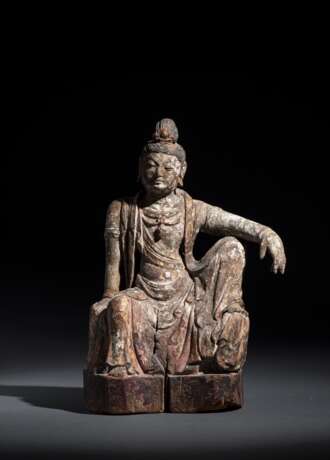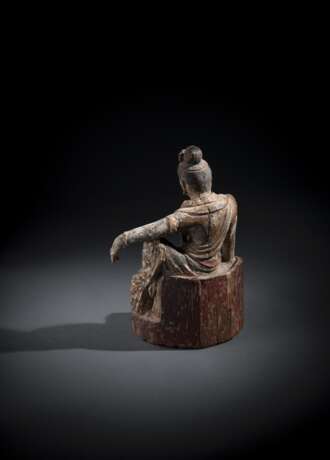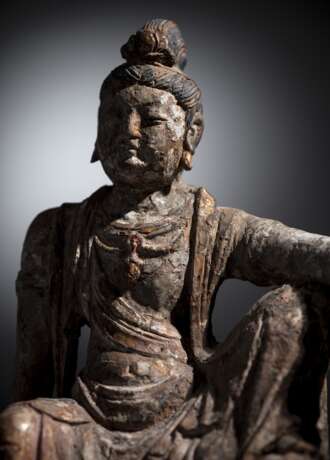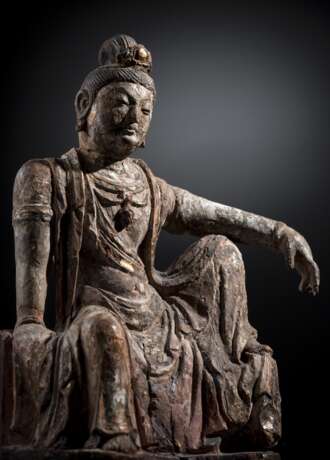ID 1215602
Lot 199 | Fein geschnitzte Holzfigur des Guanyin
Estimate value
€ 4 000 – 6 000
H. 26,5 cm
In Rajalilasana auf einem Podest sitzend dargestellt, trägt sie ein lockeres Gewand, das vorne in knackige, gut definierte Falten fällt, und einen langen Schal, der über die Schulter, quer über den Oberkörper und über das linke Knie geschlungen ist. Der Hals wird von einer juwelenbesetzten Kette umrahmt, die Arme sind mit Armbändern und Armreifen geschmückt, die zarten Gesichtszüge haben einen friedlichen Ausdruck unter dem sorgfältig frisierten Haar, das über die Ohren geschlungen und zu einem Haarknoten hinter einem blattförmigen Diadem hochgesteckt ist. Spuren von schwarzem und weißem Pigment, Gesso und Vergoldung.
Laut Überlieferung aus einer alten Berliner Privatsammlung, zusammengetragen in den 1920er Jahren in China
Diese anmutige Figur des Bodhisattva Guanyin sitzt in einer Variation der Pose, die in der indischen Ikonographie als rajalilasana oder "königliche Gelassenheit" bekannt ist. Das rechte Bein ist angehängt, während das linke angewinkelt und angehoben ist, so dass der rechte Arm des Bodhisattva knapp unter Schulterhöhe lässig auf dem Knie ruhen kann. Der Oberkörper neigt sich ganz leicht nach rechts, wodurch der Eindruck entsteht, dass der rechte Arm, der gerade ist, das gesamte Gewicht des Körpers zu tragen scheint. Diese Pose wird oft mit einem der populärsten Aspekte des Bodhisattva in Verbindung gebracht. Eine große Guanyin-Skulptur der Nördlichen Song in dieser Pose, die allerdings auf einem Lotusthron sitzt und auf das dritte Jahr von Yuanfeng (1079 n. Chr.) datiert wird, befindet sich im Chongqing-Tempel in der Provinz Shanxi (abgebildet in Zhongguo meishu quanji, diaosu bian, 5, Wudai Song diaosu, Beijing, 1988, S. 65, Nr. 64. Solche Skulpturen, einschließlich des vorliegenden Exemplars, werden vor allem mit Nordchina in Verbindung gebracht, insbesondere mit der Provinz Shanxi in der Zeit vom 10. bis zum 14. Jahrhundert, aufgrund der herausragenden Zentren des Buddhismus in Taiyuan und Wutaishan. Eine weitere ähnliche Figur, datiert auf ca. 1025 n. Chr., befindet sich in der Honolulu Academy of Arts. Eine Guanyin in dieser Pose, datiert auf ca. 1200 n. Chr., befindet sich in der Sammlung des Victoria and Albert Museum, London, und wird von J. Larson und R. Kerr in Guanyin - A Masterpiece Revealed, London, 1985, ausführlich besprochen. Eine Figur von Guanyin in ähnlicher Haltung, datiert auf ca. 1250 n. Chr., befindet sich in der Sammlung der Princeton University, wo die Kuratoren anmerken, dass die Reliefdekoration auf dem Rock und den Tüchern der Figur wahrscheinlich während der Ming-Dynastie hinzugefügt wurde. Eine große Song-Skulptur von Guanyin in dieser Pose befindet sich auch in der Sammlung des British Museum, London (siehe Buddhism: Art and Faith, London, 1985, Nr. 296), während sich eine etwas kleinere nördliche Song-Figur des Bodhisattva Manjusri in ähnlicher Pose in der Sammlung des Metropolitan Museum befindet (siehe Wisdom Embodied - Chinese Buddhist and Daoist Sculpture in the Metropolitan Museum of Art, New York, 2010, S. 180, Nr. A44 - Leichte altersbedingte Schäden, rechte Hand überarbeitet, Abriebe und kleine alte Reparaturen
| Address of auction |
Nagel Auktionen GmbH Neckarstrasse 189 - 191 70190 Stuttgart Germany | ||||||||||||||
|---|---|---|---|---|---|---|---|---|---|---|---|---|---|---|---|
| Preview | |||||||||||||||
| Phone | +49 (0)711 649 690 | ||||||||||||||
| Fax | +49 (0)711 649 69696 | ||||||||||||||
| Buyer Premium | 29,5% | ||||||||||||||
| Conditions of purchase | Conditions of purchase | ||||||||||||||
| Business hours | Business hours
|
